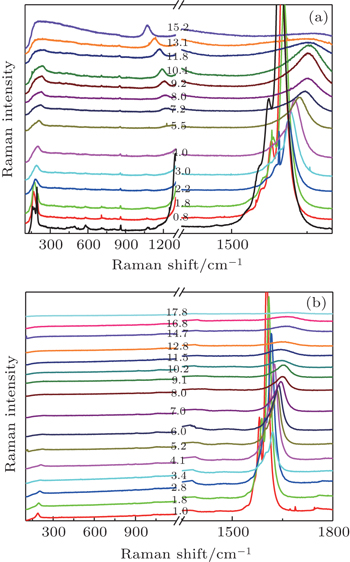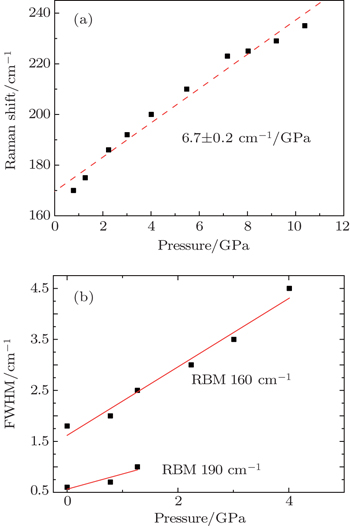† Corresponding author. E-mail:
Raman spectra of C60 filled single-walled carbon nanotubes (C60@SWNTs) with diameters of 1.3–1.5 nm have been studied under high pressure. A plateau in the pressure dependence of the G-band frequency at around 10 GPa was observed in both experiments with 514 nm and 830 nm excitation lasers, which is similar to the high pressure behaviors of pristine SWNTs. This structural transition has been assigned to the transformation into a peanut-like structure of the nanotubes. At pressure below 2 GPa, no obvious Raman signature related to the structural transition of nanotubes was observed, unlike what has been reported for C70 filled nanotubes. We discussed this point in terms of the arrangement differences of C60 and C70 molecules inside the nanotubes. At higher pressure up to 15 GPa, a graphite-like pressure evolution was observed in our C60@SWNTs.
Carbon nanomaterials, especially single-walled carbon nanotubes and C60, as important one-dimensional (1D) and zero-dimensional (0D) materials, have become an important object in the nanomaterial research field because of their unique structures and exotic physical and chemical properties.[1–3] It is theoretically predicted that Young’s modulus of C60 is twice as large as that of diamond, up to 700–900 GPa,[4] thus C60 is considered as a potential superhard molecule. On the other hand, the single-walled carbon nanotube (SWNT) is considered as a one-dimensional material with a hollow tubular structure. It is hard at the axial direction with a very large modulus, but soft in the radial direction, so the single-walled carbon nanotube changes its structure under a low pressure. For example, the cross sections of SWNTs with diameters of 1.3–1.5 nm are changed at a critical pressure of approximately 2 GPa.[5,6] Therefore, it is expected that the C60@SWNTs (SWNTs filled with C60) peapod sample can serve as an ideal model of 1D superhard material[7] due to the supporting effect of the filled C60s, and it is important to study its mechanical properties for fabricating 1D superhard material. High pressure is a powerful technique to study and tune mechanical and electronic properties of materials. Previous reports are mainly focused on the polymerization and rotating dynamics of the internally filled C60,[8–10] but little attention has been paid to the high pressure stability and structural changes in the host SWNT itself, probably due to limited knowledge about the structural transitions of pristine SWNT (no filling) under high pressure. Recently, a detailed study on the structural evolution of pristine SWNT under high pressure has been performed by our group using density functional theory calculations and high-pressure Raman spectra, and it was found that the structural evolution can be identified by the change of the Raman signal.[11] Recently, C70 filled SWNTs peapods and iodine filled SWNTs were studied by Raman spectra.[12–14] In sharp contrast to our expectations, it was found that the doped SWNTs collapsed even at lower pressure compared to pristine SWNTs, which may be caused by the inhomogeneous doping.[14] In addition, compared to the high-symmetric C60 molecules, the elliptical shape of C70 molecules and their arrangements of either standing or lying in the nanotube channel, may also affect the structural stability of the SWNTs under high pressure. At present, the detailed research on the high-pressure structural deformation of C60-doped SWNTs has not been reported. In this paper, the effect of C60 doping on the structural evolution of SWNTs under high pressure is studied by Raman spectroscopy.
SWNT samples used for doping in the experiment were synthesized by arc discharge, and purified by a procedure with oxidation and acid treatments.[15,16] The peapod samples were fabricated by a vapor phase diffusion method. Firstly, C60 powder (99.9%) and SWNT powder were mixed and heated to 823 K for 96 h. Then the mixed powder was cooled down to room temperature, followed by ultrasound in a toluene solution for 1 h to remove the C60 adsorbed on the outside surface of the nanotube. After drying, the highly pure peapod samples were obtained. A diamond anvil cell (DAC) with culet size of 500 μm was used to create high pressure. Methanol and ethanol mixture (volume ratio 4:1) was used as the pressure transmission medium and ruby was used for pressure calibration. Raman measurements were performed by a spectroscopy (Renishaw inVia) equipped with excitation wavelengths of 514 nm and 830 nm. The highest pressure reached in this study was 21.5 GPa.
The high-resolution transmission electron microscopy (HRTEM) image of C60@SWNTs is shown in Fig.
The Raman spectra of the peapod samples measured at ambient pressure and high pressures are shown in Fig.
 | Fig. 2. Raman spectra of C60@SWNTs peapod samples under atmospheric pressure and high pressures, with laser excitation wavelengths of (a) 830 nm and (b) 514 nm. |
As the pressure increases, the RBM and G-band of the SWNTs gradually shift to higher frequencies, while the intensities gradually decrease, as shown in Fig.
 | Fig. 3. (a) Pressure dependence of RBM frequency (initial frequency−1) and (b) FWHM of RBMs of peapod sample. Excitation wavelength is 830 nm. |
Firstly, we compare the results of SWNT samples filled with C60 with those of pristine SWNT sample under high pressure. For the pristine SWNT sample, the G-band plateau (frequency is independent of the pressure) is observed in the pressure range from 8 GPa to 14 GPa, while the curve of the RBM frequency as a function of pressure is linear.[11] Combined with the theoretical simulation, we suggest that the cross section of SWNT changes from oval to flat oval, and even to peanut-like shape. Interestingly, for the C60@SWNTs peapod, the G-band plateau is observed in the pressure range from 8 GPa to 13.5 GPa, which is similar to that observed in the pristine SWNTs. We thus believe that a similar structural transition occurs in both samples in the plateau region.
Figure
The curves for the RBM frequency of SWNTs with or without C60 filling as a function of pressure are linear throughout the plateau stage of G-band (Fig.
Let us now turn to discuss the structural evolution of SWNTs filled with C60 under high pressure. For the C70@SWNTs peapod, it was found that FWHM of RBM (diameter similar to this work) changes suddenly with pressure at 2 GPa,[14] which was explained by the cross section change of SWNT from circle to ellipse shape. With pressure increased to 10–15 GPa, a plateau was also observed in the curve of the G-band frequency versus pressure, which was interpreted by the collapse of the SWNTs. In our experiment, for the C60@SWNTs peapod samples, it is observed that the frequency and FWHM of RBM increase with pressure, indicating no obvious change of the cross section of SWNT at least below 4.4 GPa, or only a gradual cross section change under pressure, different from the behavior of the C70-peapod sample. As we know, C70 can stand or lie in the interior channels of SWNTs. As the pressure increases, SWNTs are squeezed and the standing C70 molecules may change to lie in the SWNTs, resulting in less support from the C70 molecules, and thus the nanotubes easily deform.[19] In contrast, C60 is a highly symmetric spherical molecule, and no arrangement change like that of C70 occurs in SWNTs upon compression, so no obvious change is observed in the RBM FWHM below 2 GPa. As the pressure increases, C70 molecules change to lie in SWNTs and the supporting effect of C70 to the SWNT is similar to that of C60 (equivalent short-axis diameter between C60 and C70). Further increasing pressure leads to the presence of a G-band plateau in the C60- and C70-peapod, suggesting a similar structural transition of the nanotubes, i.e., structural collapse of SWNTs, forming similar pod-shaped SWNTs as suggested in Ref. [14]. This transformed structure is different from that of the collapsed hollow SWNTs, for which a peanut-like structure is formed due to a serious radial deformation.
At pressure above 14 GPa, the slope of the pressure dependence of G-band frequency is similar to that of graphite, which indicates that the integrated interaction from the intertube interaction, and the interactions between the interior walls and the C60 molecules, as well as the interior walls of the deformed SWNTs, is similar to that of layered graphite under high pressure.
The structure evolution of C60@SWNTs peapod under high pressure has been studied by Raman spectra and several structure transitions were observed. At around 10 GPa, SWNTs filled with C60 have a similar structural transition to that of pristine SWNTs and C70-peapod, and transform to a peanut-like structure. At higher pressure, G-band of the peapod shows similar Raman evolution to that of graphite under pressure, indicating that the interaction between SWNT and C60 increases. It should be noted that at low pressure, no obvious change is observed in the RBM FWHM of SWNTs filled with C60, in contrast to the case of compressing C70-peapod, which can be interpreted by the different arrangement of C60 in SWNTs compared to that of C70 due to the different molecular shapes.
| 1 | |
| 2 | |
| 3 | |
| 4 | |
| 5 | |
| 6 | |
| 7 | |
| 8 | |
| 9 | |
| 10 | |
| 11 | |
| 12 | |
| 13 | |
| 14 | |
| 15 | |
| 16 | |
| 17 | |
| 18 | |
| 19 |




